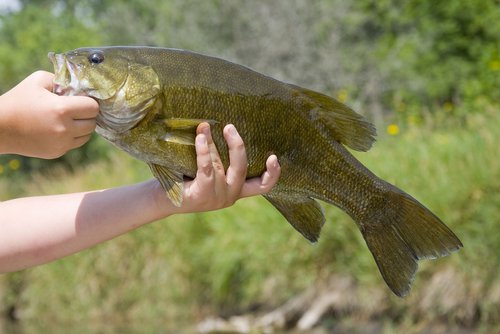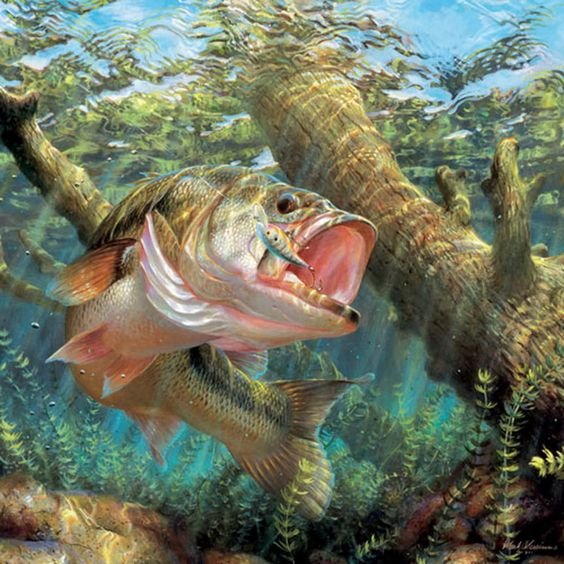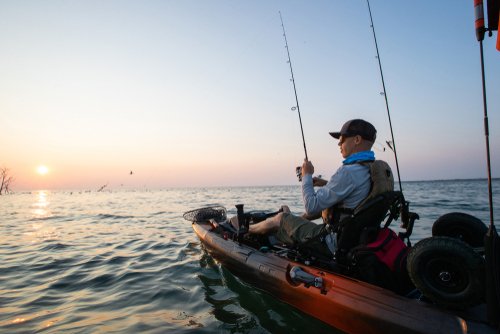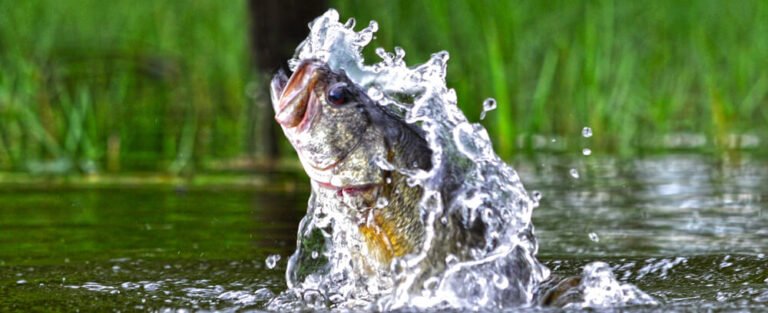Raindrops aren’t just unwelcome guests, they’re aquatic energizers. As they pummel the surface, they unleash a surge of oxygen into stagnant zones, rousing bass from their slumber. This rain-triggered frenzy creates a unique window of opportunity for bass fishing in rain. For the angler armed with the right approach, rain isn’t a deterrent, it’s a chance to unlock explosive bass fishing. Let’s get after it!
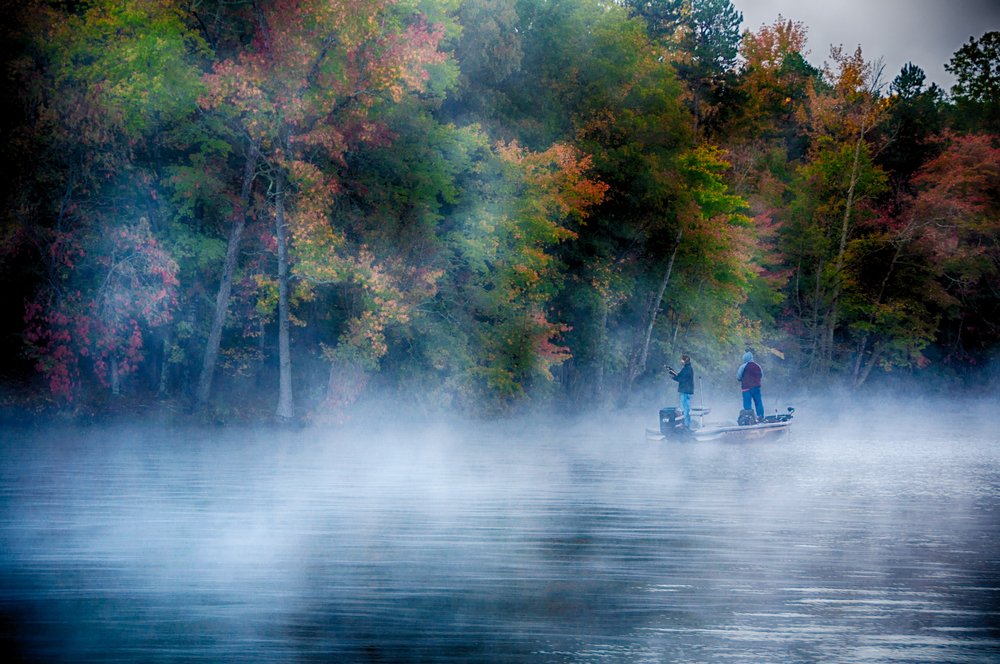
This influx of oxygen attracts baitfish and other prey species, which lure hungry bass seeking an easy meal. As a result, you have a higher chance of finding active and feeding bass during or immediately after rainfall.
Cooler Water Temperatures that Stimulate Bass Activity
Another perk of bass fishing in winter or rainy conditions is the cooler water temperatures. Bass are cold-blooded creatures, meaning their metabolism slows down as temperatures drop.
However, the cooler water stimulates their activity levels during and after rain showers, especially when rain-induced changes in water temperature make them more aggressive or alter their feeding patterns.
This is because the water temperature directly influences their behavior; as the temperature drops, bass become more aware of surface disturbances and may change their feeding habits to conserve energy.
Unlike scorching summer days when they tend to be sluggish and seek shelter, they become more active in search of food during these optimal conditions.
So, if you’re looking for fishing adventures, targeting bass after rainfall can significantly increase your chances of success, particularly by matching the retrieval speed of the lure to the cooler water temperature.
Reduced Fishing Pressure
Picture this: you arrive at your favorite fishing spot only to find it packed with other anglers vying for their share of the catch. Frustrating, right? When it’s raining or immediately after rainfall, many anglers prefer staying indoors or leaving early due to weather concerns or discomfort.
This reduced fishing pressure means less competition for you! The fish are there, but fewer people are trying to catch them.
So seize this opportunity to have quieter waters and enjoy uninterrupted casting without worrying about encroaching lines. Bass fishing in the rain brings distinct advantages that can improve your chances of landing big bass.
The increased oxygen levels caused by rainwater agitation attract more prey, enticing hungry bass to feed. Additionally, cooler water temperatures during and after rain showers stimulate their activity levels, making them more likely to bite.
The reduced fishing pressure from anglers allows you to enjoy a more serene fishing experience with less competition.
So next time it rains, don’t let it deter you; don’t waste the opportunity for an exciting and potentially rewarding bass fishing adventure!
Gear and Equipment for Bass Fishing in Rain
Waterproof clothing and accessories to stay dry
Investing in the right rain gear, such as waterproof jackets, pants, and boots, is crucial for staying dry and comfortable while in the rain. A good rain jacket with sealed seams and an adjustable hood will shield you from the rain falling from above and any water splashing up from below.
Look for jackets made with breathable materials that allow moisture to escape while keeping you dry. Remember to complete your ensemble with waterproof pants or bibs with reinforced knees.

These will dry your lower body and provide durability when kneeling or moving around on slippery surfaces. Please pay attention to the fit, ensuring they are roomy enough to layer underneath easily.
Neoprene gloves to keep hands warm and dry
Your hands are the most important tools for catching bass, so it’s crucial to protect them during wet conditions. Neoprene gloves are an excellent choice as they offer both warmth and superior water resistance. The neoprene material is an insulator, keeping your hands cozy even when wet.
Look for gloves with reinforced palms or fingertips for added durability when handling fish or gripping wet surfaces such as fishing rods. Opt for snug gloves without restricting skill, enabling you to tie knots or handle small lures without hassle.
Specialized tackle for rainy conditions
Fishing in the rain requires adjustments to your usual arsenal of bass lures. In murky water caused by rainfall runoff, visibility becomes challenging for anglers and fish alike.
Spinnerbaits
Willow leaf spinnerbaits create extra flashiness that helps bass locate and strike your lure. The elongated shape of the willow leaf blade allows it to spin quickly, producing strong vibrations that attract bass even in low-visibility conditions.
Plastic worms
Soft plastic worms rigged weedless are also a must-have for rainy fishing. With the increased water flow and vegetation stirred up by rainfall, bass tends to seek shelter among thick cover. Rigging your soft plastic worms weedless helps prevent snagging on vegetation, allowing you to target hidden bass havens effectively.
Top water lures
Don’t forget about top water lures that create enticing splashes during rainfall. Bass are known for being opportunistic feeders, and when raindrops create surface disturbances, they often mistake them for potential prey. Topwater lures such as poppers or buzz baits can mimic these natural splashes and trigger aggressive strikes from bass seeking an easy meal.
These baits create enticing splashes during rainfall and will fully prepare you to tackle the challenges of fishing with rain. Remember that adapting your gear to match the weather conditions is key to maximizing your chances of success on the water!
Additionally, incorporating topwater baits like buzz baits, torpedoes, Zara Spook, Whopper Plopper, and popper frogs during rain or right before a storm can significantly enhance your chances of attracting aggressive bass feeding closer to the surface.
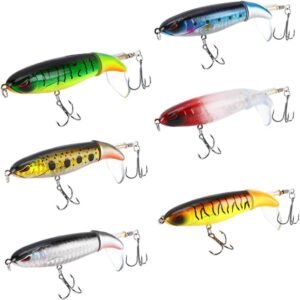
Specialized tackle for rainy conditions
Fishing in the rain requires adjustments to your usual arsenal of bass lures. In murky water caused by rainfall runoff, visibility becomes challenging for anglers and fish alike.
That’s when spinnerbaits with willow leaf blades come into play—they create extra flashiness that helps bass locate and strike your lure. The elongated shape of the willow leaf blade allows it to spin quickly, producing strong vibrations that attract bass even in low-visibility conditions.
Soft plastic worms rigged weedless are also a must-have for rainy bass fishing. With the increased water flow and vegetation stirred up by rainfall, bass tends to seek shelter among thick cover.
Rigging your soft plastic worms weedless helps prevent snagging on vegetation, allowing you to target those hidden bass havens effectively. Don’t forget about topwater lures that create enticing splashes during rainfall.
Bass are known for being opportunistic feeders, and when raindrops create surface disturbances, they often mistake them for potential prey. Topwater lures such as poppers or buzz baits can mimic these natural splashes and trigger aggressive strikes from bass seeking an easy meal.
Equipping yourself with waterproof clothing and accessories like a quality rain jacket, reinforced waterproof pants or bibs, neoprene gloves, and specialized tackle such as spinnerbaits with willow leaf blades, diggable soft plastic worms, and topwater lures.
These baits create enticing splashes during rainfall and will fully prepare you to tackle the challenges of bass fishing in the rain. Remember that adapting your gear to match the weather conditions is key to maximizing your chances of success on the water!
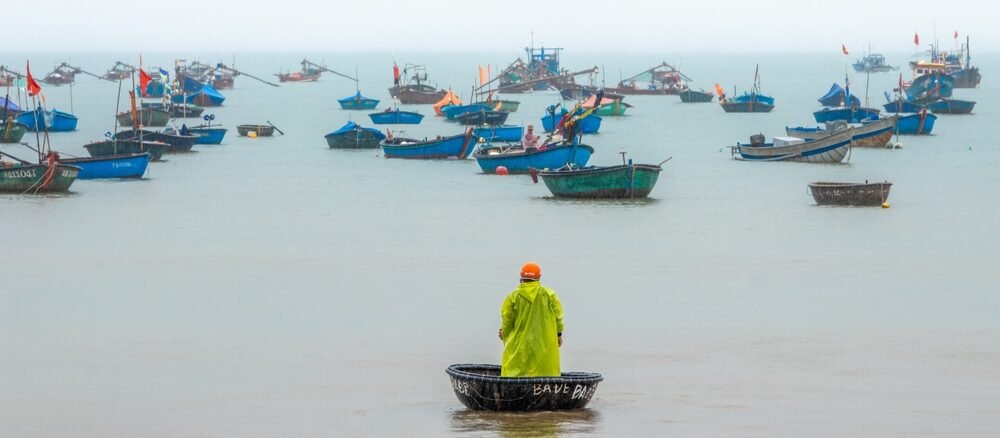
Techniques and Strategies for Fishing in the Rain
Shallow Cover: Where Bass Seek Shelter from Raindrops
As the rain begins, bass behavior shifts, leading them to seek shelter in shallow cover areas. This change is driven by the anticipation of freshly oxygenated water and the potential for increased food availability.
Targeting these areas becomes a key strategy for fishing. As raindrops fall, the bass often moves closer to shorelines, docks, or fallen trees to protect themselves from the elements and take advantage of the heightened activity in these spots.
Look for areas with overhanging vegetation or submerged structures where bass can find refuge. Casting your lures near these shallow cover locations increases your chances of enticing hungry bass.
Slowly Retrieving Topwater Baits
In rainy conditions, bass tend to be more sluggish and less likely to chase after fast-moving baits. Try a slow retrieval technique that mimics injured prey struggling in the water to maximize your success. This can be achieved using soft plastic worms or creature baits rigged weedless.
Cast them around the cover and allow them to sink slowly before starting a gentle retrieve with occasional pauses. This imitates an easy meal for bass that conserves energy but triggers their predatory instincts.
Utilizing Scent-Based Attractants
With reduced visibility due to rainfall, scent-based attractants on your baits can greatly enhance their effectiveness. Bass have an incredible sense of smell and rely on it heavily when hunting for food. Consider using scented soft plastic baits or special attractant sprays to increase the chances of attracting nearby fish.
Popular scent options include those that mimic natural baitfish or crawfish scents, known favorites of bass year-round. You’ll increase your chances of landing a catch even during a rainy day by strategically targeting shallow cover areas where bass seek shelter from raindrops and employing slow retrieval techniques that mimic injured prey struggling in the water.
Why Scent-Based?
Additionally, using scent-based attractants on your baits enhances their effectiveness in low-visibility conditions. So the next time you’re faced with rain, you’re on a fishing adventure.
Don’t be discouraged; don’t it as an opportunity to employ these effective techniques and bring home a memorable catch! Adding scent-based attractants is a proven strategy to catch fish during rain when visibility is low, and bass rely more on their sense of smell.
Safety Considerations to Catch Bass
Fishing during rain storms, or rain fishing, can be unpredictable, and it’s crucial to be prepared when a water column hits. Safety should always be your top priority, and this means keeping a constant eye on the weather forecast and being ready to take cover or head back if conditions worsen.
Understanding the impact of rain on water conditions and fish behavior is key, but never at the expense of personal safety. The last thing you need is a high-pressure downpour.
Monitoring Weather Forecasts and Avoiding Thunderstorms

Staying informed about the weather is crucial when planning a fishing trip in the rain. Before heading out, check multiple reliable sources for accurate forecasts. Watch for any signs of thunderstorms or severe weather that could risk your safety.
Be particularly cautious of weather changes and plan your fishing around rain breaks. Fish might be super active before any rain drops, slow down until the rain breaks up, and then become active again when bugs and runoff start hitting the water.
Remember, postponing your fishing adventure is better than putting yourself in harm’s way; however, if you get unexpectedly caught in a storm while already on the water, seek shelter immediately and wait until it passes before continuing.
Being Cautious of Slippery Surfaces on Docks or Riverbanks
Fishing during rainfall means dealing with wet surfaces that can become extremely slippery. Always exercise caution when moving around, Whether on a boat, dock, or riverbank. Wear appropriate footwear with good traction and take slow and deliberate steps to prevent accidents.
If you’re fishing from a boat, ensure that it has non-slip deck coatings or use additional grip pads for added safety. Additionally, be mindful of algae growth or mossy areas, as they can be particularly slippery when wet.
Maintaining Proper Hydration Despite Cooler Temperatures
While cooler temperatures during rainy days may make you feel less thirsty than fishing under scorching summer suns, it’s essential not to neglect hydration. Bass fishing requires physical exertion and concentration regardless of the weather conditions.
Dehydration can affect your performance and decision-making abilities on the water. Always bring plenty of water and drink regularly throughout your fishing trip.
Don’t rely solely on beer or sodas; use water to hydrate yourself. Keeping a close eye on weather forecasts, being cautious of slippery surfaces, and maintaining proper hydration can ensure a safe and enjoyable fishing experience in the rain.
Remember, while the rain may offer unique advantages for catching bass, it’s crucial to prioritize your safety above all else. These safety considerations allow you to maximize your rainy-day fishing adventure without compromising your well-being.
Mistakes to Avoid when Bass Fishing in the Rain
Neglecting Weather Updates and Safety Precautions
Staying up on weather forecasts is crucial when fishing in the rain. Ignoring these updates can lead to unexpected thunderstorms or other severe weather conditions that could put your safety at risk.
Always have a plan B in case the weather takes a turn for the worse, and be prepared to seek shelter if needed. Additionally, be cautious of slippery surfaces on boats, docks, or riverbanks, as rain can make them quite treacherous.
Neglecting Weather Updates and Safety Precautions
Staying up on weather forecasts is crucial when fishing in the rain. Ignoring these updates can lead to unexpected thunderstorms or other severe weather conditions that could put your safety at risk.
Always have a plan B in case the weather takes a turn for the worse, and be prepared to seek shelter if needed. Additionally, be cautious of slippery surfaces on boats, docks, or riverbanks, as rain can make them quite treacherous.
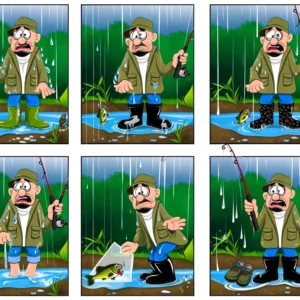
Using Incorrect Lure Presentations
One common mistake anglers make while fishing in the rain is using incorrect lure presentations. Remember that visibility is reduced during rainfall, so opt for lures that create noise or vibrations to attract bass efficiently.
Avoid relying solely on visual cues using spinnerbaits with willow leaf blades that enhance visibility in murky water conditions.
Additionally, consider using soft plastic worms rigged weedless to prevent snagging on vegetation.
Failing to Adapt Techniques
Another mistake many anglers make is sticking to their usual techniques instead of adapting them to the rainy conditions. During rainfall, bass seek shelter near shallow cover like shorelines, docks, or fallen trees.
Failing to target these areas means missing out on potential catches. Slowly retrieve your lures to mimic injured prey struggling in the water. Use scent-based attractants on baits, as they become even more effective during low-visibility conditions.

Conclusion
Fishing in the rain may seem challenging at first glance, but it offers unique advantages and exciting opportunities for anglers who embrace it with proper preparation and techniques.
Understanding the benefits of increased oxygen levels, cooler water temperatures, and reduced fishing pressure can help you make the most of your time on the water.
Remember to equip yourself with the necessary gear, tackle rainy conditions, and stay safe by monitoring weather forecasts and being cautious of slippery surfaces.
By avoiding common mistakes such as neglecting safety precautions, using incorrect lure presentations, and failing to adapt techniques, you’ll increase your chances of having a successful fishing experience in the rain.
So grab your rain jacket and head out to enjoy the thrill of wet-weather angling; it might lead to unforgettable catches and adventures!


